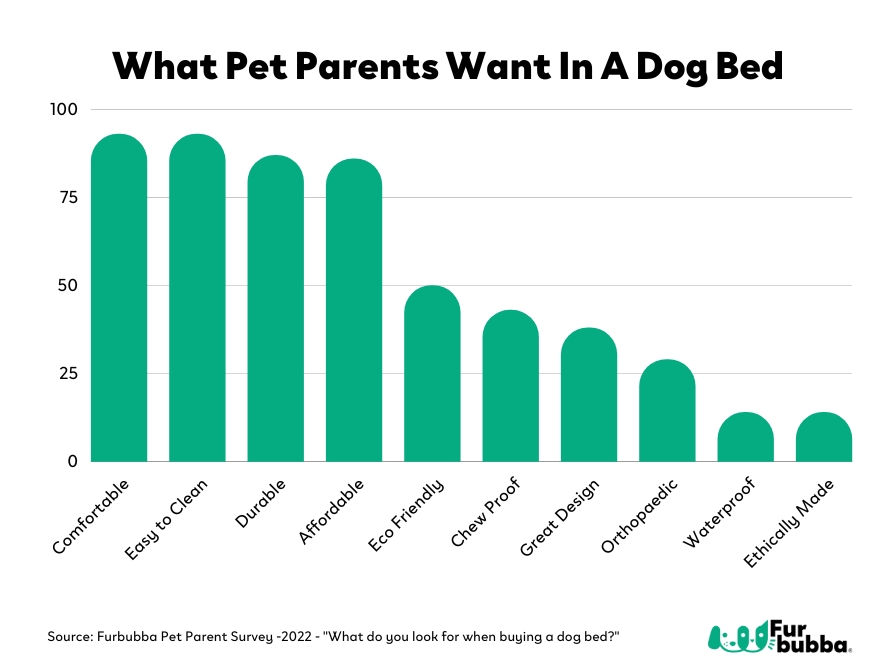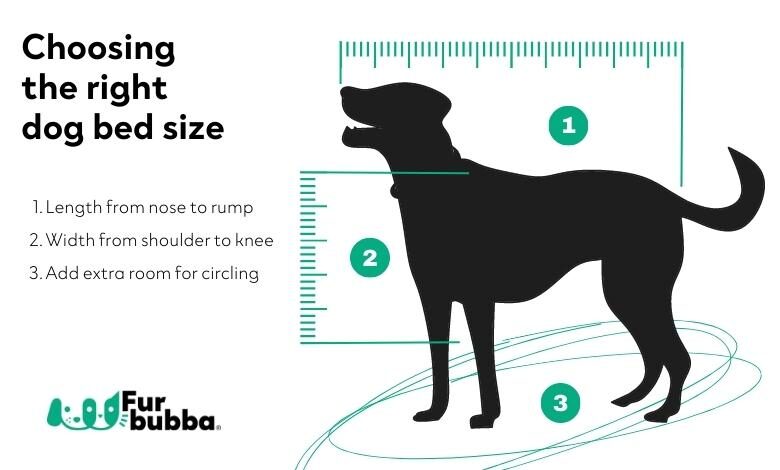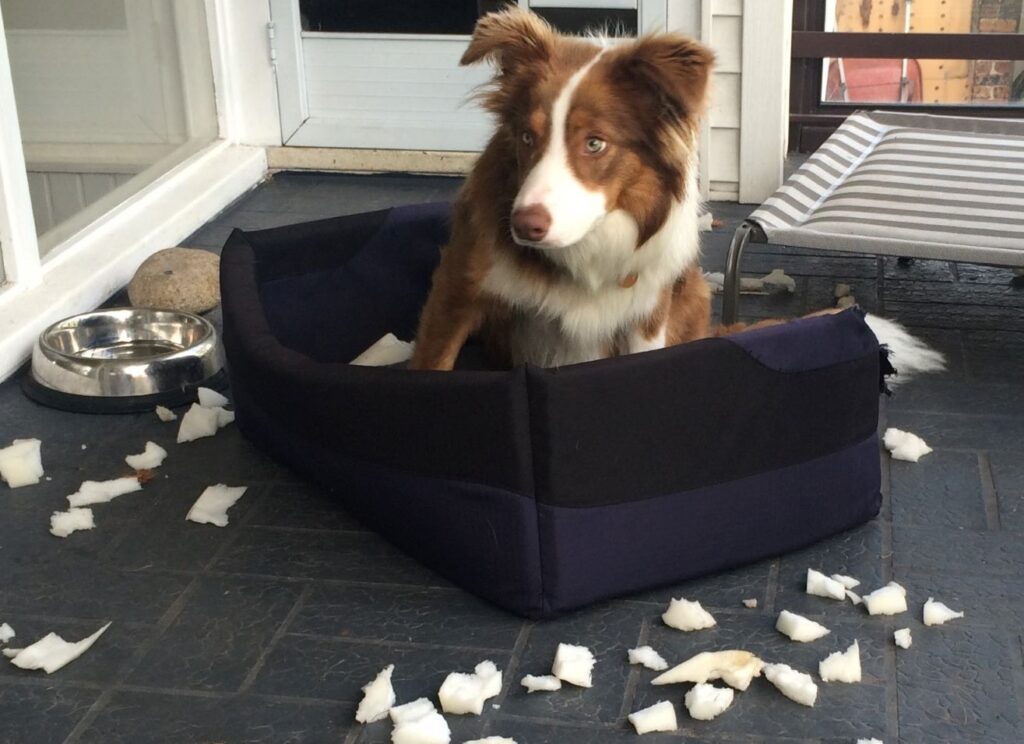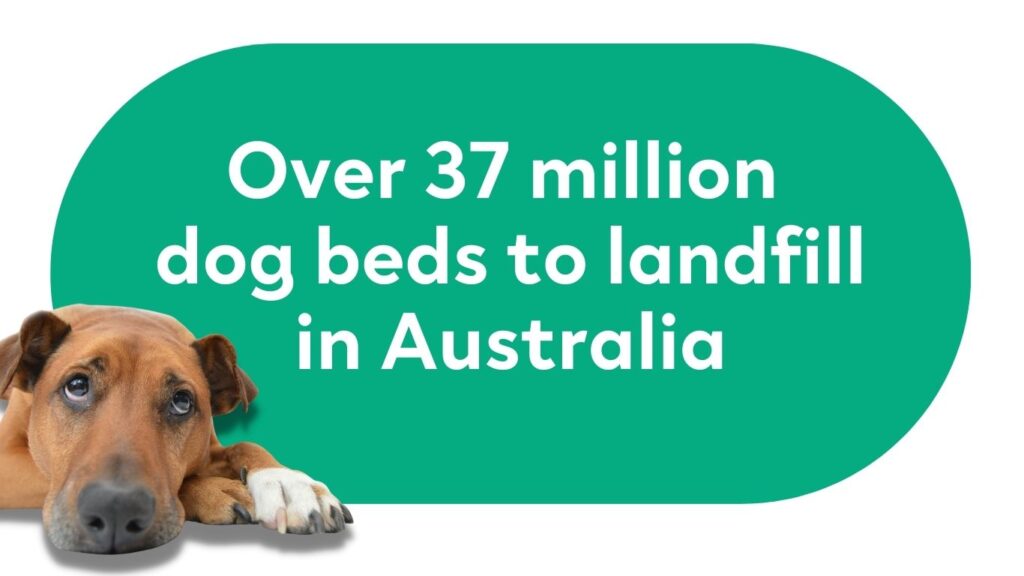Ok, so you’re at the exciting stage of picking out a place for your furry friend to rest their sleepy head, but all the options to find the best dog bed are overwhelming. While our pets love to lounge around and nap almost anywhere (mostly anywhere near you), a comfortable bed is important so they can get the quality rest they need to be their best selves.
There are a few important things to consider when choosing a bed for your dog, and picking the right bed will save you (and the planet) from unnecessary wastage. Luckily for you, we surveyed hundreds of Australian dog owners and researched thousands of customer reviews to create an easy guide that will help you understand what makes a great dog bed.

Pet parents told us that the best dog bed is comfortable and easy to clean!
What makes the best dog bed? Pet parents told us that pup’s comfort always comes first and is the most important factor when choosing the best dog bed. They also told us that there is no point in having a comfortable bed that is hard to clean! And it has to be durable, it can’t fall apart or go lumpy.
Aside from comfort, being easy to clean and being durabile, pet parents want an affordable solution – however they recognised that buying a cheap bed every couple of months soon ads up. So affordability is about considering how all these aspects work over time – preferably years rather than months!
In this guide to choosing the best dog bed, we take insights from our dog parent survey and have compiled the top things to consider when buying a dog bed for your specific furry friend…
- Which dog bed is right for my dog? From puppies, to older dogs, active to anxious dogs these are key things to consider for your specific fur-family.
- What size dog bed do I need? Understand how to measure your dog and find the perfect fit.
- Why comfort is king! Do you know how many hours a day your dog sleeps? Here’s the key comfort factors to consider.
- What makes a dog bed easy to clean? There’s easy and then there’s really easy. We have the tips you need.
- Is there really such a thing as indestructible dog beds? We look at durability and chewing.
- How much should you spend on a dog bed? Our survey has the answers.
Which dog bed is right for my dog?
When you’re looking to buy a new bed for your furbaby, it all starts with understanding their specific needs. The size and age of your dog will help you determine the best bed for them, as will their behaviours, lifestyle, and preferred sleeping style.
Best beds for Puppies
Within their first few weeks and months, puppies will normally go through a period of teething (when their adult teeth start to come in). They often relieve this discomfort by finding things to chew on – yep, including that dog bed you’ve just invested in! That’s why a new pup’s first bed shouldn’t be anything too fancy, as you’ll likely need to upgrade their bed as they reach adulthood. A good place to start when you have a brand-new puppy is to use old, clean blankets or towels. This gives a little extra comfort to help them snuggle and sleep soundly, and it makes it easier for you to wash and clean whilst they are potty training. It’s also a good way to upcycle old soft fabrics you might have in the house – just make sure there are no strings or threads that they can get caught in or swallow.
Best beds for Crate Training
If you are crate training your dog, you’ll want to make sure that the bed you choose will fit inside the specific create you have. Whilst most dog crates are standard sizes, they can differ. Those gaps between the side of the wire crate and the mattress can be dangerous, particularly for little puppies as they may get their legs caught in the gaps. So, measure carefully.
Best beds for Smaller Dogs
When your puppy has grown up and you’re ready to buy a quality bed, it is critical to think about the size and weight of your dog. Smaller dogs like Chihuahuas, Pomeranians, or Maltese need something easy for them to access and climb into and out of. High sides or extra soft stuffing can be a problem. The last thing you want is for your little furbaby to have difficulty getting out of their bed!
Best beds for Medium Dogs
There can be quite a size difference between medium sized dog breeds, a Labrador versus a Border Collie or a Cavoodle / Cavapoo will all have very different body weights and body lengths. So make sure to check the size guide carefully.
Pet parents of active breeds such as working dogs or water dogs kept telling us they wanted replaceable covers. Their dogs like to jump into bed with a little mess on them, so the ability to not only wash but also replace the covers was important.
Best beds for Large Dogs
Large dog breeds like Great Danes, Bernese Mountain Dogs or St. Bernards need a strong and sturdy bed that will support their size and weight. Whilst there are some extra-large dog beds on the market many don’t have the support needed for the weight of a large dog. Most pet parents we surveyed who have larger dogs told us that they often use an old sofa or human mattress for their big pal to sleep on.
Best beds for Older Dogs
Older dogs usually like the comfort of orthopaedic beds to provide extra support to their bones and joints, although dogs of any age and those with health issues can also benefit from them. For example some breeds have a genetic predisposition to hip problems, so an orthopeadic mattress will help throughout their whole life. A particular consideration for older dogs is that it can’t be too soft, as they will find it hard to get out of and this can reduce mobility. Covers that are waterproof and easy to wash or replace are also a big help if your dog’s bladder is not what it used to be.
Best beds for Luxury Lovers
If you have a majestic pet like a cute little Shih Tzus (who were originally bred to accompany and warm the laps of Chinese Emperors), then you might want to look for something with a little extra luxury. Let’s face it, no matter what the breed, most of our furbubba’s deserve a little luxury now and then! And all the pet parents we surveyed, said their dog love elegant faux fur to get snuggly in. We just encourage you to look for eco-friendly faux fur. And check the quality, as many fur beds shed more than your dog does and can fall apart at the first sign of a claw.
Best beds for Active Dogs
For active dogs who are always on the go, the best type of dog beds are ones that are easily washable so you can regularly clean them and ensure they are odour-free. Look for quality fabrics that are scratch proof and antibacterial mattress fillings. Micro-fiber fabrics are a great solution as they are long lasting and often water resistent.
Best beds for Anxious Dogs
For dogs with anxiety, their bed will become like a sanctuary of safety for them. A quiet, calm and dark environment can help create a safe place for dogs to sleep soundly in. You might also want to find a dog bed that is soft and cosy for them, with bolster pillows for added security and something for them to cuddle up to. They like the safety of having their back against something, but it needs to be soft enough to snuggle into.
Doughnut beds are all the rage on social media, but feedback from the pet parents we surveyed noted that they are poor quality – the filling inside clumps if washed and dogs often find them too hot as they are completely surrounded. Smaller dogs may prefer a pet cave – you will usually find them as cat caves but we don’t descriminate, they can be used by any furry species!
Best beds for Multiple Pets
If you have a big furry family with more than one dog, or maybe a dog and cat duo who enjoy snuggling up together, then you might want to look for an larger dog bed that can fit the whole furry family comfortably together. The extra bonus of course is that the photos will be great for your socials!
What size dog bed do I need?

Choosing the right size dog bed requires you to measure two things – firstly your dog, so you can pick the right size bed for them. And secondly, don’t forget to also measure the space in your house where you want to put the bed.
To get your pooch’s measurements, follow these three steps to know what size dog bed you need…
- Length of the dog bed:
Using a tape measure, start at the tip of your dog’s nose and measure to the end of their rump, where their tail begins (not to the end of their tail as they will usually curl this up when sleeping). This is how long the bed should be. - Width of the dog bed:
Next, measure your dog from shoulder to their first leg joint (whilst some will say shoulder to shoulder is the widest point, think about the width they need when laying on their side). - A little extra room to move:
Most dogs will instinctively want to circle around before sitting or laying. This instinct helps them navigate the space they have to settle into. In the wild, dogs circle to not only pat down tall grass for comfort, but as a safety precaution to ensure there are no snakes or large insects. If the bed is too small, they will not be able to satisfy this circling instinct, so add 15cm-30cm (6-12 inches) on the width and length to accomodate.
Why 'comfort is king' when it comes to dog beds

How many hours a day does your dog sleep?
It is easy to understand why pet parents say that ‘comfort is king’ when choosing a dog bed.
Did you know that a dog sleeps an average of 12-14 hours a day, while a puppy in its first year sleeps between 18-20 hours a day!
While taking a restful nap on a hard floor might be ok on occasion, considering how much time your pet is going to spend snoozing, it’s easy to see why comfort is so important when choosing a bed for your dog.
The best dog beds have comfy padding
The most comfortable bed for a dog is one with sufficient padding to hold their weight and a durable, soft exterior. Body heat for your pet is another important consideration. Just like us humans, if a pup feels too hot, they won’t be able to get a good night’s sleep. Most furbubbas love a softer feel, that’s why faux fur is so popular. Just make sure the fur of the bed is tightly woven and doesn’t shed more than your pooch does!
A comfortable bed is a clean bed, so you’ll want to pick something that is also easily washable. However, our biggest tip from pet parents was that they hate poor-quality beds where the padding clumps up into a lumpy mess, or lose their shape after the first time you wash them.
Yes, dog bed pillows are a thing!
Beds with a cushiony or slightly raised place to rest a pup’s head rated highly in our research. That’s where dog pillows come in. A pillow bolster is a long, cylinder-shaped cushion that provides extra support and security for your dog while they rest.
They can be used as a pillow to provide head support, but even more than that, supportive foam bolsters around the edges of your dog’s bed can create the sense of a fort and make your dog feel more secure. The raised enclosure of foam bolsters can remind a pup of their early days when they were amongst their litter and in their mum’s warmth. They might not look as slick and streamlined as some dog beds out there, but your furbaby is guaranteed to love it.
Does your dog need an orthopedic mattress?
Orthopedic (or orthopaedic) dog beds are beds made to specifically provide support for bones and joints. They’re made with a firm and durable filling, most of the time with a memory foam top or a memory foam base. Memory foam is a very dense type of material that moulds to the specific shape of the weight pressed against it, allowing for even distribution of your dog’s weight across the mattress. This even weight distribution can help to support sensitive pressure points or relieve joint pain in older dogs or those with arthritis. Because of their great support, orthopedic beds are also a good choice for dogs with health issues like hip dysplasia, achy joints, dogs recovering from surgery or for dog breeds that are very slim or bony like Greyhounds.
The problem with some orthopedic dog beds is that they don’t use memory foam thick enough to support your dog’s weight, so make sure that the foam is thick enough to support your dog’s specific weight if choosing this type of bed for your furbaby.
How to choose an easy to clean dog bed
Fur parents told us the one thing they disliked most about dog beds was how difficult they were to clean. Many beds claim to be easy clean, but our pet parents have learnt the hard way! Many complained about quality issues with cheap beds once washed.
So they were loud and clear in wanting something that could be easily thrown in the washing machine. A perfect solution to this is a dog bed that has a removable cover that can be washed to keep the bed refreshed time and time again. They also warned against covers that had multiple zippers which could break or were difficult to put all the bolsters back into.
In between washes a quick vacum or brush with a lint brush is a tip from some parents. Look for covers that came in materials like microsuede that allows pet hair to be effortlessly brushed off and is a great choice for easy dog bed maintenance.
Durable and chew-proof dog beds

Indestructible dog beds
We hate to break it to you, but there is no such thing as an indestructible dog bed!
As mentioned earlier in our guide, chewing is a natural part of puppy behaviour, so don’t invest in a quality bed until your pup is past that stage – usually around 1 year. If you have an adult dog that is chewing their bed, it is best to try distracting your restless furry friend with something else they can chew on rather than the bed itself. Quality chew toys are a good way to prevent your furbubba from destroying their new sleeping spot. A trick you can try is to put a dog treat, toy, or some dry food in their bed – of course, that means the dog bed cover may get a little messy – but we’ve already got the cleaning part ticked!
How long should a dog bed last?
A quality orthopedic dog bed can last for up to 10 years, but only if you have replaceable covers. A machine-washable cover is one thing, but if you can actually replace the covers with new reusable ones over a few years’ time, it can really help extend the life of your pup’s beloved bed and avoid ending up in landfill too quickly.
Pet parents told us that fashionable styles and colour options were also important when choosing a dog bed, as fitting in with your own home décor is a must. So, another benefit of replaceable covers (not just washable covers) is that you can make your dog’s bed the perfect addition to any room in the house with different styles that you can change over time.
The other end of the scale is a little tragic. Many of the pet parents surveyed said they were replacing their dog beds every few months. Whilst it might seem like a cheaper alternative, that cost adds up over the life of your pet and then there is the cost to the planet. Most dog beds are made of foam which is full of petrochemicals and with very few textile recycling facilities available, these disposable beds are ending up in landfill.
In our dog bed survey, on average 49% of people purchased a new dog bed every year. With approximately 6.3 million dogs in Australia, living on average for 12 years, we estimated a whopping 37 million dog beds will go to landfill over the life of those dogs. Sadly, this environmental impact is one of the biggest problems with our pooches’ beds.
You can be part of the solution by choosing durable, long-lasting beds made of eco-friendly materials.

How much should I spend on a dog bed?
Ok, now for the most important factor of all (drum roll, please…)
How much does a dog bed cost, you ask? This answer varies as much as there are dog bed varieties! When we asked pet parents how much they spent on their last dog bed purchase, we found that:
● Most small-sized dog beds purchased were priced between AUD $100 – $300
● Most medium-sized dog beds purchased were priced between AUD $100 – $300
● Most large-sized dog beds purchased were priced between AUD $100 – $200
● Most dog bed covers purchased were priced between AUD $50 – $100
Our furparents felt that the key factor regarding affordability was how long the bed would last and how well they could keep it looking fresh. For beds that had no removeable covers this drammatically decreases the value over time – so people would pay less than the averages above, knowing that they would have to purchase more beds in the long run. However, for those making an investment in their dogs specially health needs, the purchase price would be much higher than the averages listed above.
You've reached the end of our guide!
In summary, what makes a great bed for your dog depends on your pup’s size and needs plus your personal preferences as a pet parent. The best way to choose the right bed for your dog is to balance the practicalities for you need with the comfort and needs of your furry friend. Because when they sleep well, you’ll sleep well!.